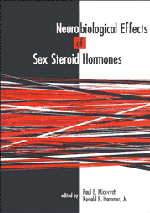Book contents
- Frontmatter
- Contents
- List of contributors
- Dedication
- Preface
- Acknowledgments
- Part I Sex steroid–responsive circuits regulating male and female reproductive behaviors
- Part II Sex steroid interactions with specific neurochemical circuits
- Part III Cellular and molecular mechanisms regulated by sex steroids
- 12 Neurosteroids and neuroactive steroids
- 13 Estrogen synthesis and secretion by the songbird brain
- 14 Neurobiological regulation of hormonal response by progestin and estrogen receptors
- 15 Molecular actions of steroid hormones and their possible relations to reproductive behaviors
- 16 Effects of sex steroids on the central nervous system detected by the study of Fos protein expression
- 17 Developmental interactions of estrogens with neurotrophins and their receptors
- 18 Sex steroid influences on cell–cell interactions in the magnocellular hypothalamoneurohypophyseal system
- Index
13 - Estrogen synthesis and secretion by the songbird brain
Published online by Cambridge University Press: 15 October 2009
- Frontmatter
- Contents
- List of contributors
- Dedication
- Preface
- Acknowledgments
- Part I Sex steroid–responsive circuits regulating male and female reproductive behaviors
- Part II Sex steroid interactions with specific neurochemical circuits
- Part III Cellular and molecular mechanisms regulated by sex steroids
- 12 Neurosteroids and neuroactive steroids
- 13 Estrogen synthesis and secretion by the songbird brain
- 14 Neurobiological regulation of hormonal response by progestin and estrogen receptors
- 15 Molecular actions of steroid hormones and their possible relations to reproductive behaviors
- 16 Effects of sex steroids on the central nervous system detected by the study of Fos protein expression
- 17 Developmental interactions of estrogens with neurotrophins and their receptors
- 18 Sex steroid influences on cell–cell interactions in the magnocellular hypothalamoneurohypophyseal system
- Index
Summary
Steroid hormones act on the brain to influence its organization during development and its activity in adulthood, thereby regulating behavior and physiology. Achieving these effects on the brain is often the culmination of a complex set of events within the endocrine system. During development, the sequence begins with the differentiation of steroid-secreting organs and their expression of steroidsynthetic enzymes. In adulthood, it continues with the regulation of the activities of one or more of these enzymes by pituitary trophic factors. After secretion, but before the steroid reaches targets within specific brain cells, the hormone is subject to a variety of regulatory influences. These can include steps to-inactivate the molecule by peripheral catabolism and excretion. The presence of carrier proteins in blood can limit the availability of free steroid to enter tissues. Having reached a target organ, the steroid may encounter additional enzymes that catalyze changes in its structure, rendering the molecule inactive. Alternatively, the steroid may be converted to a molecule with increased biological activity or one that functions along an alternative steroid-activating pathway. When these transformations are complete, the steroid is available to influence cellular function by interacting with intracellular protein receptors. Once bound to ligand, the steroid receptor can bind to specific DNA hormone response elements to influence the transcription of specific genes. The active steroid may also influence cell function without changing gene expression by interacting directly with cell membranes or with other cellular processes.
- Type
- Chapter
- Information
- Neurobiological Effects of Sex Steroid Hormones , pp. 297 - 323Publisher: Cambridge University PressPrint publication year: 1995
- 8
- Cited by

